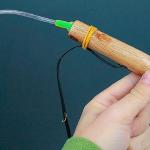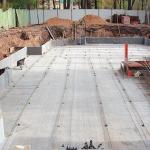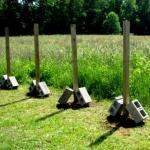Drill attachments, as well as attachments for this power tool, endow it with new functions and the ability to successfully solve various technological problems. Devices for equipping a drill allow it to be used not only for drilling, but also as a power saw, milling cutter, small lathe or even a pump for pumping liquids. Modern manufacturers offer a wide variety of nozzles and attachments that make the drill truly multifunctional.
Of course, nozzles and other devices will not make a drill device comparable in performance and processing accuracy with specialized equipment, but it can be used quite successfully to solve simple technological problems with their help. It is very convenient to use the elements of additional equipment of the drill to solve construction and repair tasks, as well as many other issues related to the maintenance of housing in proper condition.
Varieties of devices for additional equipment of the drill
The most common is a drill attachment such as a stop, which allows you to easily and quickly drill holes to the required depth. The design of the simplest thrust fixture includes an auxiliary handle and the thrust itself, on the surface of which a metric scale is applied.
A more complex design and, accordingly, greater functionality has a parallel stop, with which you can control not only the depth of the hole being made, but also the position of its axis relative to the surface of the workpiece or structure. Attachments of this type are also available for tools used in construction and repair, and for wood drills.

Parallel stops, designed for use with construction and repair tools, are installed on powerful drills, with which they drill holes in concrete and brick building structures. This type of attachment consists of a stop with a scale and an auxiliary handle for a drill. Some models of rip fences have a built-in suction for removing waste products, which is connected to a vacuum cleaner.
Popular among home craftsmen are drill attachments, with which it can be used to perform carpentry work. A drill equipped with such an attachment is, in fact, a small milling machine. In its design there is a vertical rack with guides along which a special basket with a power tool fixed in it moves. Of course, this one is not able to provide the same accuracy and productivity of the processing performed as specialized equipment, but it is suitable for simple work in the home workshop.

A fairly large category among the elements of additional equipment of a hand-held electric tool is nozzles and attachments for a drill, with which you can perform drilling at an angle. Such a device for drilling holes works where it is not possible to use a conventional drill. The working head, depending on the model of this equipment, can be located at different angles (up to 90 °) with respect to the axis of rotation of the main drill chuck. The most popular and in demand are devices for drilling at an angle of 90 degrees.

Devices for drilling holes are widely represented on the modern market, which allow not only to limit the depth of the holes created and control the verticality of their axis, but also to use the drill as a small milling cutter. Such devices are especially popular among home craftsmen who are independently engaged in the manufacture of furniture.
When using various working attachments on a drill for woodworking, it is possible to perform many technological operations (in particular, side drilling of holes in products of a round or more complex configuration, requiring the use of special liners). On some models of such devices, special suction devices are installed, connected to a vacuum cleaner, with the help of which dust and small chips are removed from the processing area. It should be borne in mind that even such functional devices do not allow you to make a full-fledged hand mill from a drill, which has the same operational capabilities, but provides higher accuracy and quality of the processing performed.
Dust extractor for drill

No one will dispute the fact that it is much more convenient to use not a drill, but a drilling machine to form holes (and the accuracy of processing using stationary equipment is higher). Meanwhile, it is also possible from a hand-held power tool, for which it is used. Most modern models of such a device are equipped with a vise for fixing the part during processing, as well as a bed along which such a vise can move freely. The power tool itself is placed in a special drill holder (basket), which is a universal clamping device and can be used for almost any model of drilling tool. Such a device, on the rack of which an accurate metric scale is applied, is a very useful acquisition for any home craftsman, as it allows you to make holes with less labor and higher accuracy.

Attachments to the drill are very popular, allowing it to be used as a wood lathe. Such equipment is fixed on the desktop, and the drill itself acts as its drive mechanism. To install the drill in the design of such a prefix, a special stand and a mounting mechanism are used.

Such consoles are available in various designs, with a different set of cutting tools and fixtures, make it easy to realize the dream of many home craftsmen to have their own lathe at their disposal. Of course, a lathe driven by a conventional electric drill cannot be compared with specialized equipment either in terms of service life or in terms of accuracy and productivity of the processing performed. If you use such an attachment in intensive mode, the electric drill will not withstand significant and prolonged loads and will eventually fail. That is why, in order not to be left without a drill, such an attachment should be used to perform simple and not too long turning woodwork.
The most popular drill attachments include attachments that allow you to turn such a tool into an electric sharpener or emery. With their installation, there are no difficulties even for inexperienced craftsmen. Such attachments can be used not only for sharpening knives and circular saw blades, but also for restoring the geometric parameters of drills, turning tools, chisels and planer knives. Thus, using such devices on a sharpening drill, you can not only solve many household issues with their help, but save on contacting qualified specialists. Even those who do not have experience in this field can successfully use such emery, including for sharpening cutting tools.

Additional equipment for a drill is necessary not only for home craftsmen, but also for professional furniture makers. Such equipment, in particular, includes a milling attachment, with which grooves are made in joinery and furniture elements to create corner joints. When using such an attachment, there is no need to fix the workpieces in the clamping device. It provides high processing accuracy, and special adjusting elements are provided in its equipment to create a groove of the required width and depth.
In order to effectively use the tools driven by the drill even in the most inaccessible places, you can purchase a flexible drive or an angle adapter.

The flexible drive and the angled nozzle on the drill are fixed at one end in the drill chuck. Their second end is equipped with a clamping device in which drilling, milling, abrasive and any other tool with a shank of a suitable diameter can be fixed. When choosing between two such devices, it should be borne in mind that the flexible drive has more possibilities in terms of processing hard-to-reach places than the angled nozzle for a drill. The bending angle of such a drive is not limited to 90°, it can be any.
Application examples for angled nozzles
The question of whether it is possible to use an electric drill as a pump drive for pumping liquids is not without meaning. In order to practically solve such a problem, you can not come up with various homemade products, do not rack your brains over making a reliable mount for a drill on a typical pump housing and over which adapter to use. All these issues have already been thought out by specialists and implemented in the design of the attachment-pump.

Such a pump for a drill, although not intended for long-term and intensive use, is able to effectively solve many problems. In particular, it can successfully pump small volumes of both viscous liquids (such as oil or paint) as well as ordinary water. To change the pumping speed of a liquid medium, it is enough to change the number of revolutions made by the drill chuck. Since drill pump housings are usually made of plastic, they do not have a long service life, but this disadvantage is compensated by the low cost of such devices.

Electric drills are often used in combination with special templates, which not only increase the accuracy of drilling and further assembly, but also significantly speed up the processing process. Templates for professionals are made of metal, retain their geometric parameters for a long time. For home use, you can purchase an inexpensive plastic template, which, although not as durable as their metal counterpart, provides high precision machining.

The meaning of drilling templates lies in the fact that their design includes the sizes and arrangement of holes most often performed in elements of furniture structures. So, there are templates designed for drilling holes for fixing furniture hinges, inserting locks and installing furniture ties. In such templates, not only the distance between the holes being made is precisely maintained, but also the distance at which such holes should be located from the edge of the workpiece.
Types of nozzles for drills
The nozzles used with drills are also used to expand the functionality of the latter. This includes, in particular, a range of drill bits for cutting sheet metal. Such nozzles for a metal cutting drill can work as punching or nibbling scissors. Even when used with a conventional drill or screwdriver, they show high efficiency. For example, such an attachment for a cutting drill is able to cope with a metal sheet up to 1.5 mm thick, a mesh made of metal, and thick plastic.

In most cases, it is better to use the nozzle on the drill for cutting metal, and not a manual or electric jigsaw. This is explained by the fact that the jigsaw, like many other devices with which you can cut sheet metal, contribute to intense heating of the processing zone. This may cause the protective coating applied to the surface of the sheet to burn off. Among the most popular drill bits used for cutting sheet metal are devices called "Cricket" and "Steel Beaver", as well as devices that look like metal shears, but are powered by a drill or screwdriver.
Among home craftsmen, as well as those who are professionally engaged in car body repair, grinding and polishing nozzles for drills are very popular. The working body that such grinding attachments are equipped with can be a drum with sandpaper glued to its surface, as well as a felt or felt disk.

The material through which the nozzle on the drill for grinding will be in contact with the surface to be treated is selected depending on the nature of the technological task. Thus, a grinding tool, with which coarser processing is performed, is often made of an abrasive material of the appropriate grain size, and felt or felt is glued onto the polishing material. As a polishing tool, a brush attachment is also used, which is installed in the drill chuck using its shank.
The drill attachment for polishing a car can be used not only after a body repair has been completed, but also in cases where the owner of the vehicle wants to give it a pristine shining look. If you want to save on the purchase of grinding nozzles for a drill, you can make such a device with your own hands. For this, a home-made wooden drum is suitable, in the central part of which it is necessary to securely fix the shank. With the help of this structural element, such a device will be fixed in the drill chuck. Grinding and polishing with a drill using such a drum can be carried out using materials such as sandpaper, felt and felt.

The nozzles for power tools used for cleaning products from various materials work on a similar principle. So, for cleaning metal products, metal and abrasive nozzles, as well as a brush nozzle, can be used. The brush is made of metal wire and allows you to effectively clean the surface of the product from dirt, rust and remnants of the old paintwork. The brush itself, which is equipped with such nozzles, can be located on the end or side of the device (it all depends on the tasks to be solved). Similar nozzles also differ in the material from which the brush is made. Such materials, in particular, can be polymer fibers or metal wire.
Using the mortar attachment, you can turn an ordinary drill into an efficient construction mixer. The kneading of building and finishing mixtures, which is carried out with the help of a mixer nozzle for a drill, is carried out not only quickly, but also with high quality. It is only important not to exceed the volume of the mixed mixture, so as not to reduce the efficiency of using such a device.

Speaking of what can be done with the help of additional equipment used complete with a hand-held electric tool, we should also mention the riveter attachment for a drill. The tool on which such a nozzle is installed must have a reverse function, and the rivet fixed with such a device can only be of the pull type.
The drill has long been used not only for drilling holes in various materials. This tool has found its application not only in the construction industry, but also in the design and assembly of furniture. To do this, special types of nozzles are installed on the tool, which are called wood cutters. Wood cutters for a drill allow you to carry out different types of processing wood materials. To do the job right, you need to choose the right nozzle.
Types of cutters for wood processing
A wood cutter for a drill is somewhat reminiscent of a drill, however, instead of a cutting edge, there are teeth of various designs. The possibility of performing certain technological operations depends on the shape of the teeth. To fix the nozzle in the tool chuck, the cutter has a cylindrical shank.
The working part of the nozzles is sharpened on high-precision equipment, and specialized grades of steel are used for their manufacture. Their service life depends on the quality of the steel used for the production of nozzles. Milling nozzles for a drill are of the following types:
- Attached, the dimensions of the mounting holes of such products are 32 mm, and they are intended to perform the corresponding tasks on stationary milling machines
- End mills are also called finger cutters, and their landing zone can have dimensions from 8 to 12 mm. Such products are suitable not only for stationary milling machines, but also for hand drills.

Milling cutters are produced for their intended purpose, depending on the types of wood materials that they plan to process. One of the most reliable and wear-resistant are products designed for processing plywood. Their main advantage is the inserts made of hard alloys, which has a positive effect on the service life of products. Depending on what operation is planned to be performed in wood material, the milling cutters are divided into the corresponding types (molding, disk, folded, fillet, etc.).
How to work with a drill with a cutter
Before picking up a tool and fixing a nozzle in its cartridge, it should be understood that only rough work can be carried out in this way. To achieve perfect finishing of the material, you will need to use a milling machine.
To use a wood cutter on a drill, you need to understand the features of performing these actions. The principle of operation of the nozzles is similar to drilling, only in this case the material is processed, obtaining various types of holes and shapes in it. In order to process wood with such a nozzle at home, you need to resort to the construction of a milling machine with your own hands from a drill.

Not many home craftsmen know which drill is suitable for milling. To obtain high precision of carved shapes in wood, it is necessary that the tool has a speed control function and a large power reserve. A drill as a milling tool is not the best solution, as such negative factors contribute to this:
- Negative impact on the tool gearbox
- Tool heats up quickly, shortening tool life
- Probability of misalignment in relation to the workpiece being machined
- Insecurity of fixation in the tool chuck
Despite all these shortcomings, hand tools continue to be used to work with a wood cutter. When performing work, you must comply with the following rules:
- Don't rush to get the job done
- act carefully
- Hold workpiece securely
- Take periodic pauses to allow the instrument to cool down
This is interesting! If you plan to work for a long time with a wood cutter, then for such purposes it will not be superfluous to purchase a special nozzle made of carbide materials. As soon as the nozzle is securely fixed in the key chuck of the tool, you can begin to perform the appropriate actions.
The choice of wood cutters for a drill
When choosing nozzles, their parameters are important. Nozzles come in not only different types, but also differ in the types of materials that they plan to process. Some of the main criteria for selecting milling nozzles include:
- The size of the product, which depends on the technological task
- The shape of the cutting knives, on which the final result depends
- Sharpening angle
- Material of production, which affects not only the capabilities of the nozzle, but also their service life
- Purpose. Nozzles can be used not only for processing wood materials, but also for metals, plastics and various types of natural stone.

When choosing a product, you need to pay attention to the manufacturer, but if you plan to use the nozzles in question for drills, then it is advisable to buy cutters from inexpensive products.
Do-it-yourself vertical milling cutter
It is quite difficult to work with a drill in the chuck of which such a nozzle is installed, and it is almost impossible to get a final result. If there is no milling machine at hand, but you need to use a milling nozzle to perform rough work, then a conventional drill will do. To do this, it is recommended to fix it in a vertical position, and securely fasten it.

Milling homemade machine
In order to rough wood processing, you will need an appropriate set of wood cutters, as well as a home-made machine from a drill, which you can do yourself. The manufacture of the installation does not require any skills and knowledge, and in each individual case the design may differ. The main rule of such an installation is the reliable fastening of the tool.
To make a homemade milling machine from a drill with your own hands, you will need to perform a number of the following steps:
- A table is being made, for which wood is needed. The amount of wood needed to make a table depends on the size of the future device.
- Creating a site with a limiter. The drill will be fixed in this area and moved using the appropriate guides. For the manufacture of the site, you can use chipboard and steel tubes
- Installing the tool on the site. To fix the tool, you need to use steel plates and threaded connectors in the form of bolts and nuts.
- Making a handle through which the tool moves vertically up and down

The milling machine from the drill is ready for work. You can install the appropriate cutters in the chuck and start testing it. Do not forget that you need to work with extreme caution, since the slightest wrong movement, and the tool can be pulled out of the installation structure.
If the constructed device with your own hands passes the first test, then you can make a control panel for it to facilitate work. Such a tool has one significant advantage - it can be used for both milling and drilling. At any time, the drill can be removed and used outside the structure. Do not forget about the negative impact on the drill when working with nozzles, which greatly reduces the life of the tool.
In terms of a power tool, a drill can be quite versatile. In fact, it's just an engine in a housing, with a comfortable handle. It can be used both for its intended purpose and for other types of work: engraving, grinding, polishing. One of the tasks is milling.
At first glance, it is enough to simply install a milling cutter instead of a drill, and complex machining of workpieces can be performed. Actually, it is not. The technical features of the electric drill imply certain limitations when using non-standard nozzles.
- Shaft bearings are designed only for longitudinal load, along the axis. Some types of cutters involve the application of transverse force - this wears out the mechanisms of the drill.
- The speed of the drill shaft is usually lower than the speed of the milling machine (sometimes the difference reaches 10 times). Therefore, high-speed cutters are definitely not suitable.
- The cooling mode (more precisely, the ventilation holes) may not be protected from the ingress of chips and sawdust during milling.
- The motor is not designed for continuous operation (due to overheating), it is necessary to periodically give time for rest (cooling).
- Drill handles are not designed for precise positioning relative to the workpiece.
In addition, the cartridges of a drill and a traditional machine are different. The cutter must be very firmly fixed, otherwise the tip may fall out under load. In addition to the risk of injury, you can simply ruin the workpiece.
Of course, the drill must be equipped with a holder that will fix it on the desktop, or at least a guide.

It is dangerous to work with the cutter while holding the tool in the air with your hands.
Choosing a cutter for a drill
In principle, nozzles for milling with a drill are no different from ordinary ones; they do not even stand out in a separate class. Since working with metal for a router from a hand drill is impossible, consider the types of wood cutters.
Any cutter consists of two parts: a shank and a cutting tip. The rod, which is fixed in the chuck, is made of mild steel so as not to collapse under vibration. But for the cutting edge, hard, but brittle grades of steel are used. The design can be collapsible: the tips are changed on the shank when changing the operating mode.

It is better not to use this type of nozzle, the drill does not hold it too securely anyway. There are a lot of whole copies on sale.
For information: Non-separable cutters wear out faster (the metal is not so hard), however, when used at low speeds, this drawback is leveled.
The main types of cutters are shown in the illustration:

- Fillets give the edge a recess with an inner radius, or make a symmetrical groove in a flat surface. Used with guides only.
- Moulder cutters can process a lump in the same way as fillet cutters, but they are more convenient to work with. On the outer part of the shank there is a support bearing, thanks to which the cutter can work according to a template (including a round one). The drill is held in the hands, while maintaining verticality.
The cutting edge comes in both inner and outer diameters.
- Slotted classic tips have a narrow specialization - making technological "slots" for fastening parts together. They are made in the form of a cylinder (straight), or in the form of a dovetail (structural). In such grooves, the connection will be much stronger.
- Edge processing to cut off any irregularities is done with a straight edge cutter. This bit can be operated with or without a bearing on the shank. In the second case, the guide of the drill must “slide” along the template: for example, a rule fixed to the board with clamps.
- A cone edge cutter cuts at a predetermined angle. This work can also be done with a straight cutter, but then the guide for the drill must have rotary nodes.
Advice: if you have a choice, you should buy cutters with the largest possible tip diameter. First, they are easier to center. Secondly, such tips sit more firmly in the cartridge.
It is undesirable to use more complex cutters on a drill, since low speeds imply a too smooth surface after processing. You will have to grind them with the same power tool.

Safety at work
- It is better to use a cam chuck, because without a key retainer it will not be able to secure the fastening.

- After each stage of work, check the fixation, or simply tighten the cartridge with a key.
- The drill is not equipped with a protective screen (unlike a hand router), so you should work with goggles and gloves. Clothing with loose sleeves is not allowed.
- Since the revolutions are small, the vibrations of an unbalanced cutter do not interfere much. However, when sharpening edges, it is desirable to maintain a perfect circle. No tooth should be longer.
- Disc cutters with a large immersion depth cannot be used on a drill. When wedging, the tool will simply break out of the hands. Blame again low rpm.
Advice: Since the drill is not equipped with a spring mechanism and a milling depth limiter, you should practice on a material of similar hardness. Having fixed the desired depth on the base plate, you can start finishing work.
Outcome
You can use standard cutters when working with a drill, the main thing is to observe the restrictions set forth in our material.
An electric drill is an indispensable tool that can be found in almost every home, it is more than a motor with a chuck and a comfortable handle. It is the drill chuck that is the device that allows you to use it with advanced functions. The only exceptions are stops designed to fix the drill and accurately set the position and direction of movement.
Classification of nozzles and fixtures
Accessories and nozzles for a drill can be divided into several groups - according to functionality.
Groups of nozzles and accessories for a drill:
- stops and clamps that allow you to accurately position the tool and limit the depth of the holes;
- nozzles-stops for forming holes at different angles and precisely adjusted right angles;
- nozzles with the functions of cutting metals, wood, plastics, plate materials;
- polishing and grinding nozzles, wheels, brushes, abrasive tools;
- whisks for mixing mortars, paints, plaster mixtures, adhesives;
- electric drill driven pumps.
This list may not include all categories of nozzles and accessories, since their choice is huge, and new devices appear constantly. They are produced not only by industrial enterprises, but also by craftsmen.
Stops, frames, guides, machines
In this category, you can find several types of devices, the task of which is either to limit the displacement of the drill relative to the drilling axis, or to make its translational movement as accurate as possible in direction.
The design of most stops consists of two guides, drill position locks, the frame itself or a socket for installing the tool.

The guides can be supplemented with return springs that repel the tool in the absence of human effort. Some stops have worm gears for moving and locking, designed to slowly advance the tool or set it in a certain position.

The stops have two clearly separated categories - fixed on the drill and fixing the drill itself. The second, mounted on a table or workbench, give the drill the function of a moving part, the carriage of a drilling or grinding machine. Craftsmen manage to make lathes. These are very specific devices that are far from always being used in the daily practice of using a drill. Their acquisition must be clearly motivated - either you are a craftsman who extracts a certain profit from the tool, or you are a collector or a lover of metalwork and turning.

The cost of stops varies widely, as there are many options for their designs, level of complexity and functionality. The simplest fixture in this class is the parallel stop, which limits the depth of penetration of the drill into the material. Fixed machines are the most expensive part of this section, designed for professional use.
Advanced drills
The main task of an electric drill is to drill holes, and the set of tools for this is very wide. In addition to the usual sets and single drills in this class of fixtures, you can find and use:
- a Forstner drill with a centering point and wide side cutting surfaces. The tool allows you to make holes in the tree of small and medium diameter without passing through the material. Thanks to the point, this drill can make holes for installing hinges, very precisely located in relation to the edges of the board;

- feather drills for working with wood allow you to make wide, up to 60 mm holes for installing fittings in solid wood and board materials. The center point and wide side stays are designed for precise recess positioning and limited depth. The drills have a characteristic flat configuration;

- crown-nozzle - a tool with a complex shape for sampling material from solid wood and chipboard, fiberboard, concrete and metal. Robust wide cutting surface with a characteristic profile works as a chisel or group of chisels, selecting a hole with a diameter of up to 100 mm. In the center of the nozzle there is a drill that defines the first, centering hole and guides the entire nozzle;

- drills for wood, concrete, metal - a wide range of different configurations, including especially durable drills for working with concrete. In this group, you can also find nozzles for vibration and percussion machines, which are close in functionality to perforators.

Regarding the cost and the need to have the tools from this list, we can say that the choice of options is very large. The most expensive in the category will be a complex nozzle for sampling wide holes - this is a professional tool that will not fit any drill.
Drill bits - home or professional
Fountain drills and Forstner tools belong to the semi-professional category - they can be purchased and kept in a set, but it should be borne in mind that such specific devices do not have to be used in everyday practice. They will be useful for those who like to work with furniture, carpentry professionals, for assembling doors.
A set of conventional and victorious drills is worth having in the house all the time, and the more diameter options there are, the better. In an apartment with concrete walls, it is extremely difficult to do without a victorious drill. Nozzles for hammers and impact drills are considered in two versions - professional for builders and repairmen with powerful hammers and for home use, designed to work with a drill with extended functionality.
Angle adapters for drilling in hard-to-reach places
In this group of devices, gearboxes are most often found - gear and friction assemblies that change the angle of rotation through the use of an additional mechanism and their own drill chuck. These are a kind of extension cords that are mounted on a drill and hold the drill in its chuck, making it possible to get into narrow places.

Here it is worth thinking about choosing a device according to its capabilities.
itemprop="video" >
The best option would be a nozzle with a variable angle, almost universal, which costs a little more than a fixed one, but makes it possible to get anywhere. To use such a gearbox, you will need a drill with increased power and good torque, but for a person who does all the housework himself, the device can be a good helper.

Cutting attachments for electric drill
In this category, you can find at least two options for the design and use of accessories for an electric drill - classic scissors for working with sheet materials and the so-called “crickets”, which allow you to make even cuts and drill wide holes.
Scissor attachment
Scissors confidently work with steel up to 3 mm thick, they can cut polycarbonate sheets, aluminum profiles, plastic, roofing materials. The nozzle is chosen by force, the range for selection is wide, and the tool can be adapted to a professional powerful drill and to a home car.

In a private house or garage, such a device will not interfere with an amateur master, because working with sheet materials is always relevant. Powerful scissors will require the purchase of a drill with the appropriate parameters.
Cricket nozzle or nibbler
Professional fixture for working with sheet and roofing materials, capable of cutting sheet steel 1.5 mm thick, stainless steel up to 1.2 mm, plastic, aluminum and copper up to 2 mm. The main advantage of cutting shears of the “cricket” type is the ability to accurately cut the sheet and drill holes of medium and large diameters.
The tool is indispensable for roofers who need not only precision and accuracy, but also high speed. To use the cricket requires certain skills.

Is it worth buying or keeping such a device in a home workshop?
Only on condition that you know how to use it, and the tool itself is of high quality and expensive. A low-quality cricket will not give a good cutting effect, and you will only need to use it from time to time. Cricket makes it possible to perform artistic cutting of sheet materials.
itemprop="video" >
Polishing and grinding tools for electric drill
This category consists of two large sections - polishing and grinding tools. The shape of these tools can be different, as they can be used for working on the surface, making holes and finishing seams. Depending on the purpose, the material of the tool is also selected.
Polishing accessories
It is made of felt, felt, wool and foam rubber, sandpaper. Designed to bring surfaces, holes and seams to a final smooth state, to give a gloss effect.

Professional tools include nozzles for processing holes and polishing disks - the most expensive ones, which allow you to bring various holes to the technologically necessary state, including those in car body parts.

Nozzles of this type are selected according to their main purpose and size. For a home workshop, a polishing brush is enough to treat surfaces and seams. It is worth purchasing brushes in three sizes and degrees of hardness in order to be able to process surfaces of different materials. The most common polishing pad is made from medium hard felt.
Sanding accessories
These nozzles differ in design and base material on:
- abrasive fiber discs mounted on a support plate;

- sandpaper petal heads;

- hard-alloy milling cutters for work on especially strong materials with high precision;

- grinding stones for processing edges, seams, holes;

- abrasive-polymer brushes for removing dirt from the surface of metal, wood, stone and other materials.

You may notice that in the group of tools there are exclusively professional products - these are cutters made of special hard alloys (they are also cutters) and stock grinding stones. Their use at the household level is practically meaningless.
In the home workshop and garage, it is worth having a set of petal and several nylon brushes, abrasive wheels with several grit sizes. A very important detail - when purchasing such devices, one should not forget that they are subject to rapid wear. Their cost is usually low.
whisk attachments
They are always presented in a wide selection. These tools have a variety of shapes and sizes, as they are designed for mixing dry, liquid and viscous mixtures. Whisks are usually inexpensive, but they should be chosen taking into account the work ahead - you can break the nozzle by applying it to an overly viscous solution.

Tools with characteristic vertical details are suitable for working with dry mixtures, spiral and complex nozzles are designed for mixing solutions of various densities.
For large-scale construction work, only a drill with a whisk will not be enough, in which case it is better to use a construction mixer.
Nozzles-pumps for electric drill
This is the most specific group of devices - such a nozzle can be used for pumping liquids and solutions, but on condition that you have a powerful drill. The performance of the pump is chosen according to the situation, so it is extremely difficult to talk about a specific application.

The price range in this group is very wide, because the pumps are produced by Russian, Chinese, and European manufacturers. It is difficult to say whether to buy a pump nozzle for a drill in a home workshop. In a private house and in the country, it may be needed in emergency situations, but we must not forget that the continuous operation of the drill motor is limited, and the pump will have to be stopped periodically.
At the end of the review, we will definitely note that when choosing nozzles, it is necessary to take into account the design, power and functionality of the drill, your own skills in handling the tool and the need to strictly observe safety measures!
A drill is a tool whose main function is to impart rotational motion to the drill.
The drill is irreplaceable during repair and construction of any complexity. And all this, thanks to various nozzles, adapters, attachments, adapters and other devices that make the drill a truly universal hand tool.
According to the degree of mechanization, drills can be divided into two types - manual and electric. But, regardless of the type, any of them can be used to perform such work as: drilling holes, stirring solutions, grinding, cutting and tightening / unscrewing screws. The drill can be used as a pump for pumping water and even for plucking chickens. An impact drill, according to its characteristics, can replace a hammer drill in everyday life.
It is unlikely that you can find another tool on the market that would perform as many functions. Of course, the quality of work performed using drill attachments is somewhat different from that which could be obtained using a special tool. But, in particular cases, in the household and everyday life, this is quite enough.
What is a nozzle for a drill, what types of adapters are there, what are they intended for and how to choose the right one - that's what our article is about.
The nozzle is an additional device that allows you to expand the functions of the drill.
Of the many types of them, we will choose the most popular and consider them in detail.
Types of nozzles for a drill
 A parallel stop for a drill is often included in the kit. Its main purpose is to regulate the immersion depth of the drill.
A parallel stop for a drill is often included in the kit. Its main purpose is to regulate the immersion depth of the drill.
The category of stops can include a drilling stand for a drill, as well as guides. The complex structure of such mechanisms is focused on the performance of specific tasks.
Drill stop modifications in the photo.

 Since the main purpose of the drill is still to drill, drilling nozzles are also presented in a wide variety.
Since the main purpose of the drill is still to drill, drilling nozzles are also presented in a wide variety.
 2.1 Forstner drill for wood.
2.1 Forstner drill for wood.
Has a center point. Designed for blind holes, for example, for inserting hinges in furniture production.
 2.2 Feather drills for wood.
2.2 Feather drills for wood.
The flat cutting part and the special sharpening of the pen drills allow you to make holes in wood, plywood, chipboard and OSB with a diameter of up to 60 mm. There are also feather drills for metal (prefabricated).
 2.3 Drill bit. Concrete, wood, metal. Allows you to drill a hole with a diameter of up to 100 mm.
2.3 Drill bit. Concrete, wood, metal. Allows you to drill a hole with a diameter of up to 100 mm.
 2.4 Other types. These include drills for metal, wood and concrete.
2.4 Other types. These include drills for metal, wood and concrete.
Drills are different:
- by steel grade;
- by lenght;
- by accuracy class;
- by price;
- by objective function.
3. Angle drilling bits
There are models that allow you to adjust the drilling angle, there are those in which the angle is set to 90 °. Their general purpose is to help drill a hole in a hard to reach place.

4. Cutting attachments
4.1 Turbo shear attachment (cutter)
The nozzle is designed for cutting sheet materials. It can be used for cutting both smooth and profiled sheets. Scissors work on the principle of a guillotine. This eliminates the possibility of chips and does not break the edges of the cut. Cutting thickness 3 mm.
These scissors can cut steel, aluminum, plastic or polycarbonate.

The material was prepared for the site www.site
4.2. Nozzle cricket
The scissors attachment for a cricket drill is a cutting (nibbling) scissors that allow you to get an even cut. Cricket is used for cutting sheet metal:
- sheet steel (up to 1.5 mm thick),
- stainless steel (up to 1.2 mm),
- aluminum or copper (up to 2 mm),
- plastic (up to 2 mm).
The cricket nozzle is indispensable when performing roofing work, for example, for cutting corrugated board or for metal tiles. When using such a nozzle, these materials are not deformed. Therefore, the cut is smooth and beautiful. In addition, using this nozzle, you can drill a neat, large-diameter round hole in a sheet or perform an artistic cut. The handle helps to maneuver when cutting.
The kit includes: nozzle cricket, key, plastic handle.

With this attachment, the nozzles can be cut on vertical, horizontal surfaces, as well as perform internal cuts. For a better internal cut, it is advisable to drill a starting hole.
5. Nozzles on a drill for polishing
Allow to receive ideally plain surface. There is a huge variety of polishing nozzles, which distinguish between:
- according to the material of manufacture (felt, felt, foam rubber, sheep wool);
- according to the degree of softness (super soft, soft, medium, hard);
- according to the method of fastening (with Velcro, with a stem, with holders-clamps).
Below are some types of polishing nozzles.
 5.1 Felt nozzles
5.1 Felt nozzles
 5.2 Hole polishing attachments
5.2 Hole polishing attachments
 5.3 Wheel polishing attachments
5.3 Wheel polishing attachments
6. Nozzles on a drill for grinding
Designed to prepare the surface for polishing. The quality after processing with grinding nozzles is rougher.
 6.1 Foam rubber, rubber grinding wheels (discs).
6.1 Foam rubber, rubber grinding wheels (discs).
 6.2 Sanding flap heads. A drill attachment is pieces of sandpaper connected together on a rod.
6.2 Sanding flap heads. A drill attachment is pieces of sandpaper connected together on a rod.
Flap heads are used to perform radius grinding or to process a surface with a complex profile.
 6.3 Grinding stone for drill - abrasive grinding stones on the stem. Used to remove burrs, sags, level the weld or bore existing holes.
6.3 Grinding stone for drill - abrasive grinding stones on the stem. Used to remove burrs, sags, level the weld or bore existing holes.
 6.4 Cones or carbide cutters. Boron cutters and cutters for drills for metal and wood, suitable for making holes.
6.4 Cones or carbide cutters. Boron cutters and cutters for drills for metal and wood, suitable for making holes.
 6.5 Nylon abrasive polymer brushes. Polymer-abrasive nozzles are designed to clean surfaces from rust, plaque and dirt.
6.5 Nylon abrasive polymer brushes. Polymer-abrasive nozzles are designed to clean surfaces from rust, plaque and dirt.
For example, nozzles of various configurations are used to mix wallpaper paste and for concrete. But all of them allow you to quickly get a homogeneous mixture.

Designed for pumping liquids.

How to work with a drill with a nozzle
In conclusion, it is worth saying a little about safety when working with a drill:
- securely fix the workpiece or make sure there is no wiring in the wall;
- securely fasten the drill in the tooling (chuck);
- hold the drill with both hands. Especially important when working with powerful models;
- adjust the pressure of the drill;
- do not use the reverse mode until the drill stops completely;
- use personal protective measures: goggles, gloves;
- do not touch the drill or drill head for some time after completion of work. Possible burns.
Conclusion
A wide variety of accessories, adapters, adapters and attachments for drills allows you to avoid the purchase of expensive special power tools for repairs and other household needs in the home. Therefore, buying the right nozzle will be a simple and optimal solution for a real owner. In addition, some craftsmen make homemade drill bits, but you need to be careful here, this design does not guarantee safe use.



















